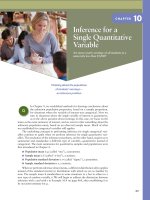3. Lecture 3 - Descriptive Statistics
Bạn đang xem bản rút gọn của tài liệu. Xem và tải ngay bản đầy đủ của tài liệu tại đây (737.13 KB, 39 trang )
Lecture 3 – Descriptive
Statistics
Content
• Measure of data’s location, variability
• Exploratory Data Analysis
• Association Between Two Variables
Measures of Location
Mean
If the measures are computed
Median
for data from a sample,
they are called sample statistics.
Mode
Percentiles
If the measures are computed
Quartiles
for data from a population,
they are called population parameters.
A sample statistic is referred to
as the point estimator of the
corresponding population parameter.
Mean
Perhaps the most important measure of
location is the mean.
The mean provides a measure of central location.
x
• The mean of a data set is the average of all the
data values.
The sample mean is the point
estimator of the population mean
.
Sample Mean x
x
x
i
Sum of the values
of the n observations
n
Number of
observations
in the sample
Population Mean
x
i
Sum of the values
of the N observations
N
Number of
observations in
the population
Median
The median of a data set is the value in the middle
when the data items are arranged in ascending order.
Whenever a data set has extreme values, the median
is the preferred measure of central location.
The median is the measure of location most often
reported for annual income and property value data.
A few extremely large incomes or property values
can inflate the mean.
For an odd number of observations:
Median 26
18 27 12 14 27 19 7 observations
12 14 18 19 26 27 27 in ascending order
the median is the middle value.
Median = 19
Mode
The mode of a data set is the value that occurs with
greatest frequency.
The greatest frequency can occur at two or more
different values.
If the data have exactly two modes, the data are
bimodal.
If the data have more than two modes, the data are
multimodal.
Caution: If the data are bimodal or multimodal,
Excel’s MODE function will incorrectly identify a
single mode.
Example:
Mode:
Apartment Rents
450 occurred most frequently (7 times)
Mode = 450
425
440
450
465
480
510
575
430
440
450
470
485
515
575
430
440
450
470
490
525
580
435
445
450
472
490
525
590
435
445
450
475
490
525
600
435
445
460
475
500
535
600
435
445
460
475
500
549
600
Note: Data is in ascending order.
435
445
460
480
500
550
600
440
450
465
480
500
570
615
440
450
465
480
510
570
615
Percentiles
A percentile provides information about how the
data are spread over the interval from the smallest
value to the largest value.
Admission test scores for colleges and universities
are frequently reported in terms of percentiles.
• The pth percentile of a data set is a value such that at
least p percent of the items take on this value or less
and at least (100 - p) percent of the items take on this
value or more.
Quartiles
Quartiles are specific percentiles:
First Quartile = 25th Percentile
Second Quartile = 50th Percentile = Median
Third Quartile = 75th Percentile
Measures of
It Variability
is often desirable to consider measures
of variability (dispersion), as well as
measures of location.
For example, in choosing supplier A or
supplier B we might consider not only
the average delivery time for each, but
also the variability in delivery time for each.
Measures of
Variability
Range
Interquartile Range
Variance
Standard Deviation
Coefficient of Variation
Range
The range of a data set is the difference
between the largest and smallest data values.
It is the simplest measure of variability.
It is very sensitive to the smallest and
largest data values.
Interquartile Range
The interquartile range of a data set is the difference
between the third quartile and the first quartile.
It is the range for the middle 50% of the data.
It overcomes the sensitivity to extreme data values.
Variance
The variance is a measure of variability that utilizes
all the data.
The variance is useful in comparing the variability
of two or more variables.
Variance
The variance is the average of the squared
differences between each data value and the mean.
The variance is computed as follows:
2
(
x
x
)
i
s2
n 1
for a
sample
( xi ) 2
N
2
for a
population
Standard Deviation
The standard deviation of a data set is the positive
square root of the variance.
It is measured in the same units as the data, making
it more easily interpreted than the variance.
Standard Deviation
The standard deviation is computed as follows:
s s2
2
for a
sample
for a
population
Coefficient of
Variation
The coefficient of variation indicates how large the
standard deviation is in relation to the mean.
The coefficient of variation is computed as follows:
s
100
%
x
100 %
for a
sample
for a
population
Measures of Distribution Shape,
Relative Location, and Detecting
Outliers
• Distribution Shape
z-Scores
Chebyshev’s Theorem
Empirical
Rule
Detecting
Outliers
Distribution Shape:
Skewness
An important measure of the shape of a
distribution is called skewness.
The formula for the skewness of sample
data is
n
xi x
Skewness
(n 1)(n 2) s
3
Skewness can be easily computed using
statistical software.
Distribution Shape:
Skewness
Symmetric (not skewed)
Relative Frequency
• Skewness is zero.
and median are equal.
• Mean
.35
.30
.25
.20
.15
.10
.05
0
Skewness =
0
Distribution Shape:
Skewness
• Skewness is negative.
• Mean will usually be less than the median.
Relative Frequency
.35
.30
.25
.20
.15
.10
.05
0
Skewness = .31









